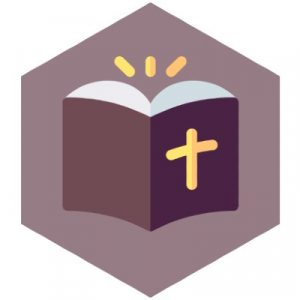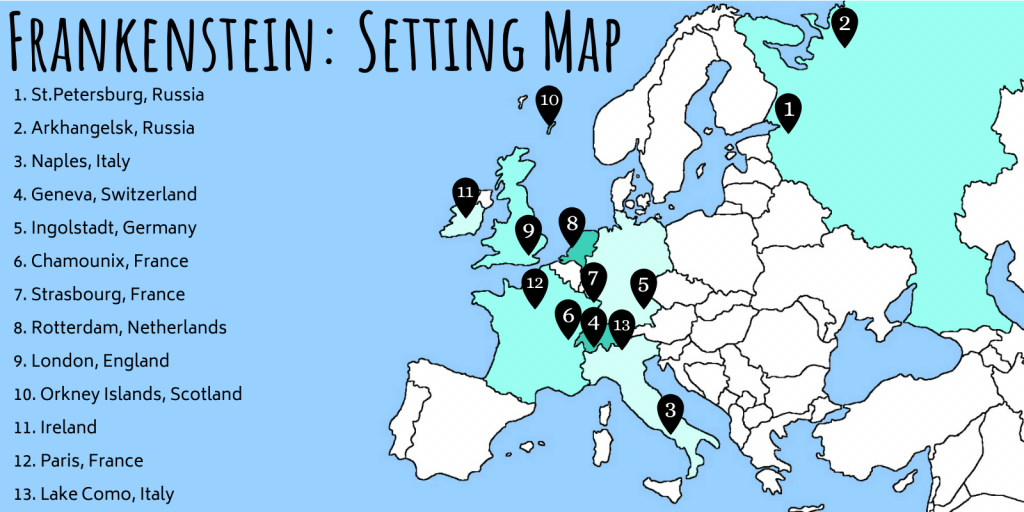Various symbols in Frankenstein help Mary Shelley convey the themes of human ambition, loneliness, responsibility, and others. Shelley enriched the novel with deep meanings, and we’re going to uncover them in this article by thoroughly analyzing all the symbols and motifs in Frankenstein. One of the most prominent elements in the novel is fire, which represents enlightenment and destruction at the same time. The monster’s fascination with fire marks his aspiration for knowledge but also reminds the dangers of overreaching ambition, as seen in Victor Frankenstein’s pursuit of scientific mastery.
According to Anne K. Mellor in Mary Shelley: Her Life, Her Fiction, Her Monsters (1988), symbolism in Frankenstein reflects the author’s warning about the consequences of unchecked desires and the moral responsibilities tied to scientific progress. By examining different literary devices and major symbols used in Frankenstein, you can better appreciate how Shelley’s Gothic masterpiece provokes critical thought on ethics and humanity.
Let’s dive into the symbolism and imagery of Frankenstein by Mary Shelley!
🃏 Frankenstein: Symbols
Mary Shelley makes use of gothic symbolism in Frankenstein. The most prominent symbols in the novel are light, darkness, Adam, Satan, and fire. They reflect the most important themes and concepts of the book. For the same reason, Shelley often resorts to allusions.
By allusion, one should understand a brief and mostly indirect reference to a person, idea, or work of literature. The author assumed that the reader is familiar with the mentioned names, ideas, and texts and will be able to understand Frankenstein’s meaning through them better. Among the writings Mary Shelley refers to in the novel are Coleridge’s Rime of the Ancient Mariner, Milton’s Paradise Lost, and Dante’s Divine Comedy.
Lightning in Frankenstein

Lightning is one of the features of symbolism in Frankenstein. It represents destruction and foreshadows future tragedy and decay. The first time Mary Shelley uses lightning as a symbol happens in the scene where young Victor Frankenstein witnesses it hitting and ruining the tree. With this, the author illustrates the power of nature over human ambitions.
Fire in Frankenstein

Fire is the most significant of Frankenstein’s symbols. It represents the idea of knowledge for both characters, the Monster, and Frankenstein, meaning that it can be good and bad at the same time. Fire, like knowledge, is beneficial until it is not mistreated, but it can burn everything down if approached too close.
Adam & Other Biblical Symbolism
Adam in Frankenstein

Among many significant allusions in Frankenstein is the allusion to the Bible. Shelley uses the so-called biblical symbolism to draw a parallel between what happens in the novel and the biblical story of Adam and Eve. The analysis of the narrative suggests that the Monster links himself to Adam, which makes his creator, Victor Frankenstein, play the role of God.
Biblical Symbolism in Frankenstein
The creature came to life innocent and utterly unaware of his background. As soon as he learned to understand the language, he stumbled upon Milton’s Paradise Lost, from which he learned that God created Adam in His own image. This book made the Monster question his own coming into being. When he accidentally finds Victor’s notes in the coat’s pocket, he realizes that he also had a creator who was supposed to be responsible for his life. In this way, the Monster and Adam have a lot in common. The creature wished to be loved by his father in the same way God loved Adam. Frankenstein, unlike God, abandoned him, making him more of a “fallen angel” than God’s son. When the Monster encounters his creator for the first time, he tells him, “Remember that I am thy creature; I ought to be thy Adam, but I am rather the fallen angel.”
The Monster’s request to create a woman for him repeats biblical motifs about the creation of Eve. Adam felt lonely without a partner, the same as the creature could not find peace without a loving soul next to him. In the Bible, God complied with his son’s wish and made a woman out of Adam’s rib, whereas the Monster was doomed to drag his miserable existence alone. Telling his story to Victor, the Monster recalls, “No Eve soothed my sorrows nor shared my thoughts; I was alone. I remembered Adam’s supplication to his creator. But where was mine?”
🖼️ Imagery in Frankenstein
Imagery – the use of rich and descriptive language – serves the purpose of making the reader feel as if the events of the novel happen to him personally. The depicted scenery always corresponds to the character’s emotions.
Shelley pays special attention to the description of nature because it most accurately reflects Frankenstein’s inner state. In writing about nature, the author utilizes a literary technique called personification. Rain, wind, rivers, mountains, and lakes are not just picturesque backgrounds but living beings with their own color, mood, and unique human characteristics.
🏰 Frankenstein Setting
Frankenstein’s story begins and ends in the Arctic Ocean aboard Robert Walton’s ship. This setting is significant as it strengthens the feeling of loneliness and isolation corresponding to both main characters’ moods. The rest of the novel takes place all over Europe, but mostly among mountains whose sublimity underlines the insignificance of a man in the face of nature.
Where does Frankenstein Take Place?
Frankenstein’s setting embraces entire Europe and takes the reader all the way to the North Pole through Switzerland, Germany, Italy, France, England, and Russia. The significance of such geographical spread is obvious if one is to notice that eventually, the path which characters follow chasing each other makes a full circle.
Frankenstein Setting Map

The story begins and ends in the Arctic Ocean near the North Pole. This land is known for its cold and uninhabited vastness. Choosing this setting for the opening and closing of Frankenstein’s story, Mary Shelley accentuates one of the most prominent themes of the novel – the theme of loneliness and isolation.
It is worth mentioning that every location corresponds to the characters’ emotions in each particular moment. Many dark and tragic events in the book happen in remote and gloomy places where the weather is dreary and depressing. For example, the Monster was created in Germany on a stormy night, the work on the second creature has begun in a secluded village of Scottish rocky coastline, the death of Henry Clerval and Victor’s imprisonment took place on a remote, unfriendly Irish island. On the contrary, positive memories of childhood and joyful days with friends were connected with the sunny and picturesque sceneries of Switzerland, France, and Italy.
When Does Frankenstein Take Place?
Mary Shelley wrote Frankenstein in 1818, but the events of the novel take place in earlier times. It is hard to say with certainty during what time period Frankenstein’s story happened, although the reader can guess at least in what century it occurred. All of Walton’s letters are dated as “17—“ suggesting that the events took place in the 18th century.
🔨 Literary Elements & Devices
Mary Shelley uses various literary devices in Frankenstein to help the reader make an intense and accurate perception of the narrative. Commonly, literary devices are understood as artistic structures and techniques that writers apply to beautify their works and emphasize their meanings.
Literary elements most often used in Frankenstein – setting, imagery, allusions, symbolism, and personification – help the reader to immerse into the gloomy atmosphere of Frankenstein’s time and live through the character’s experiences.
Who Is the Narrator of Frankenstein?
Frankenstein is written in the form of a first-person narrative, which sets a more intimate tone to the novel. There are three narrators in the book. The first one is Robert Walton, who writes letters to Margaret. When he takes Victor aboard, the story is told from Frankenstein’s point of view. The third narrator is the Monster.
Is Frankenstein a Gothic Novel?
Mary Shelley’s masterpiece is known mostly as the first science fiction novel, but one can still find a lot of gothic elements in Frankenstein. To see in what ways the author uses these elements, one should notice that she often pictures dark and wild landscapes, describes mysterious and unnatural events, and conveys a sense of horror and decay.
What is the Writing Style of Frankenstein?
Since Frankenstein is a first-person narrative, its writing style reflects the specifics of the narrator’s language. All three narrators (Walton, Victor, and the Monster) are smart and well-read. They all speak sophisticated and ornate language, often using complex speech patterns. Such a writing style is very common for the novels of the Romantic period.
What is the Purpose of Letters in Frankenstein?
Mary Shelley’s Frankenstein is an epistolary novel because the narrative is presented in the form of letters. Letters in the old times often served as the primary source of communication, and they always contained a personal touch in them. In Frankenstein, letters create the feeling that the narrator (namely, Robert Walton) speaks directly to the reader. In his letters to Margaret, he retells the story he heard from Victor Frankenstein.
Meanwhile, Victor, while telling his story, passes on the Monster’s tale and cites the letters of Elizabeth and Alphonse. This nested structure raises the question of possible misinterpretations. How can one be sure, for example, that events were not misinterpreted if they went through several points of view? In this context, it is important that Mary Shelley chooses Robert Walton as the main narrator. He was not directly involved in the events; thus, the reader can trust his objectivity. Although Walton sympathizes with Frankenstein, his narrative is not a matter of judgment. He does not particularly express his opinion on the actions of the main characters. He sets out the events, leaving the reader to decide whose side to take.
📚 Allusions in Frankenstein
In Frankenstein, Shelley often alludes to Paradise Lost by making the Monster read this book. Walton, in his letters, refers to Coleridge’s poem, comparing himself to the Mariner. The meaning of Frankenstein’s subtitle – A Modern Prometheus – is an allusion to the Greek myth. The author suggests that Victor, in his activity, resembles Prometheus, who stole the fire from the Gods.
Why is Frankenstein Called the Modern Prometheus?
There is a connection between Victor and the Greek Titan, who stole the sacred fire from Olympus. Like Prometheus, Frankenstein dared to neglect the highest power and give humanity something that only God was meant to give. In this context, the comparison between the two is fair, and it allows the reader to draw parallels between them.
Paradise Lost and Frankenstein
Throughout the novel, Merry Shelley repeatedly turns to Milton’s book Paradise Lost, sometimes referencing it directly and sometimes drawing symbolic parallels between her characters and the characters of the biblical story. The direct allusion to Milton’s work happens when the Monster finds the book in the forest. He reads it and makes connections between Adam’s birth and his own coming into being. He compares himself to Adam, saying, “I ought to be thy Adam,” but he realizes that instead of loving him as God loved his son in Paradise Lost, Frankenstein abandoned him.
Indirect allusions to Milton’s book include Shelley picturing the main character, Victor Frankenstein, as both God and Satan. Playing God, Victor dared to enter the deepest secrets of nature. He dreamed of rising above all humanity by giving life to a “new species [who] would bless [him] as its creator and source]. To some extent, he managed to obtain some similarities with God when he made a living creature from inanimate matter. However, he never cared for his child as God cared for Adam and remained apathetic to the Monster’s suffering. This, along with his ambitions and thirst for power, puts him on the same level as Satan.
🎓 References
- Langbauer, Laurie. The Wordsworth Circle, vol. 20, no. 4, 1989, pp. 210–12. JSTOR, http://www.jstor.org/stable/24042547.
